GE JVM6175YKFS, JVM6175DKWW, JVM6175DKBB, JVM6175SKSS, JVM6175EKES Installation Manual

Installation |
Over the Range |
|||
Instructions |
Microwave Oven |
|||
|
|
|
|
|
|
|
|
|
|
|
Questions? Call 800.GE.CARES (800.432.2737) or Visit our Website at: GEAppliances.com |
|||
|
|
|
|
|
|
BEFORE YOU BEGIN |
|
|
|
|
Read these instructions completely and carefully. |
• Note to Consumer – Keep these |
||
|
• |
IMPORTANT – Save these |
instructions for future reference. |
|
|
• Skill level – Installation of this appliance requires basic |
|||
|
|
|
|
|
|
|
instructions for local inspector’s use. |
mechanical and electrical skills. |
|
|
• |
IMPORTANT – Observe all |
||
|
• Proper installation is the responsibility of the installer. |
|||
|
|
governing codes and ordinances. |
• Product failure due to improper installation is not |
|
|
• |
Note to Installer – Be sure to leave these |
covered under the Warranty. |
|
instructions with the Consumer.
LA SECCIÛN EN ESPAÒOL EMPIEZA |
READ CAREFULLY. |
EN LA P·GINA 25. |
KEEP THESE INSTRUCTIONS. |
49-40765 03-16 GE
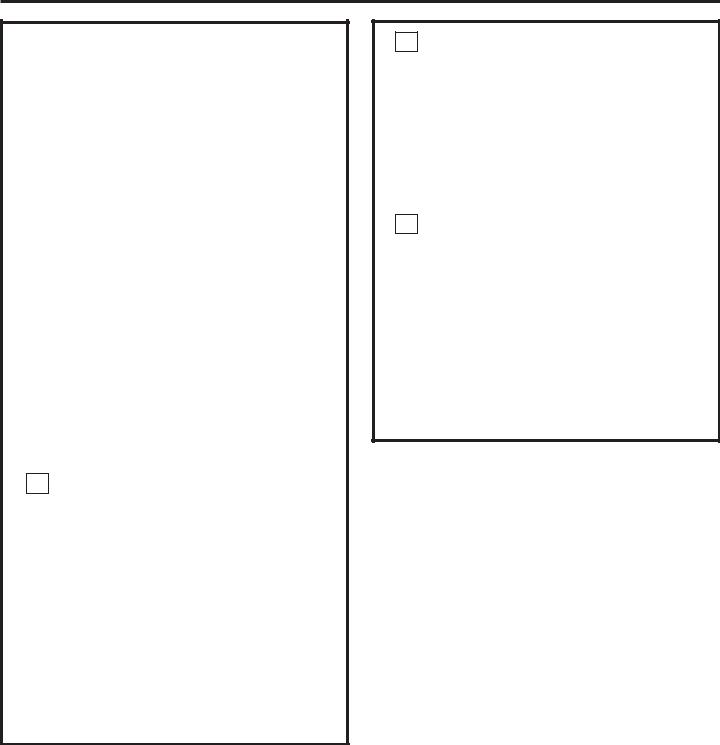
Installation Instructions
CONTENTS |
|
General information |
|
Important Safety Instructions ................................................ |
3 |
Electrical Requirements ............................................................. |
3 |
Hood Exhaust .............................................................................. |
4, 5 |
Damage – Shipment/Installation.......................................... |
6 |
Parts Included.................................................................................. |
6 |
Tools You Will Need ...................................................................... |
7 |
Mounting Space .............................................................................. |
7 |
Step-by-step installation guide |
|
Placement of Mounting Plate.......................................... |
8–10 |
Removing the Mounting Plate.................................... |
8 |
Finding the Wall Studs................................................... |
8 |
Determining Wall Plate Location.............................. |
9 |
Aligning the Wall Plate................................................ |
10 |
Installation Types................................................................ |
11–23 |
A Outside Top Exhaust............................................ |
12–15 |
Attach Mounting Plate to Wall..................... |
12 |
Preparation of Top Cabinet........................... |
13 |
Check Blower Motor Orientation ................ |
13 |
Adapting Blower for Outside |
|
Ventilation....................................................... |
13, 14 |
Check for Proper Damper |
|
Operation............................................................... |
14 |
Mount the Microwave Oven................... |
14, 15 |
Adjust the Exhaust Adaptor .......................... |
15 |
Connecting Ductwork ...................................... |
15 |
B |
Outside Back Exhaust ........................................... |
16-19 |
|
Preparing Rear Wall for |
|
|
Outside Back Exhaust ...................................... |
16 |
|
Attach Mounting Plate to Wall............... |
16 17 |
|
Preparation of Top Cabinet........................... |
17 |
|
Adapting Microwave Blower |
|
|
for Outside Back Exhaust.......................... |
17, 18 |
|
Mount the Microwave Oven.......................... |
19 |
C |
Recirculating............................................................ |
20-23 |
|
Attach Mounting Plate to Wall..................... |
20 |
|
Preparation of Top Cabinet........................... |
20 |
|
Check Blower Motor Orientation ................ |
21 |
|
Adapting Microwave Blower |
|
|
for Recirculation ......................................... |
21, 22 |
|
Mount the Microwave Oven.................. |
22, 23 |
|
Installing the Charcoal Filter......................... |
23 |
Before You Use Your Microwave........................................ |
24 |
|
2
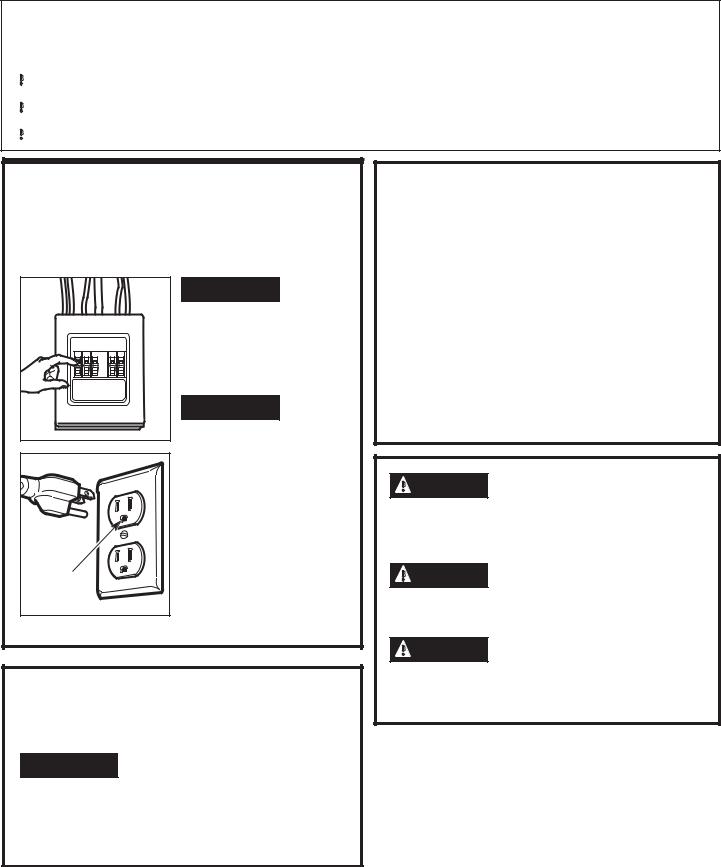
Installation Instructions
IMPORTANT SAFETY INSTRUCTIONS
 This is the safety alert symbol. This symbol alerts you to potential hazards that can kill or hurt you and others. All safety messages will follow the safety alert symbol and the word “DANGER”, “WARNING”, or “CAUTION”. These words are defined as:
This is the safety alert symbol. This symbol alerts you to potential hazards that can kill or hurt you and others. All safety messages will follow the safety alert symbol and the word “DANGER”, “WARNING”, or “CAUTION”. These words are defined as:
DANGER |
Indicates a hazardous situation which, if not avoided, will result in death or serious injury. |
|
|
WARNING |
Indicates a hazardous situation which, if not avoided, could result in death or serious injury. |
|
|
CAUTION |
Indicates a hazardous situation which, if not avoided, could result in minor or moderate injury. |
|
|
A qualified electrician must perform a ground continuity check on the wall receptacle before beginning the installation to ensure that the outlet box is properly grounded. If not properly grounded, or if the wall receptacle does not meet electrical requirements noted (under ELECTRICAL REQUIREMENTS), a qualified electrician should be employed to correct any deficiencies.
Ensure proper |
ground exists |
before use |

 WARNING
WARNING
Risk of Electric Shock. Can cause injury or death: Remove house fuse or
open circuit breaker before beginning installation to avoid severe or fatal shock injury.

 WARNING
WARNING
Risk of Electric Shock.
Can cause injury or death: THIS APPLIANCE MUST BE PROPERLY GROUNDED to avoid severe or fatal shock.
The power cord of this appliance is equipped with a three-prong (grounding) plug which mates with
a standard three-prong (grounding) wall receptacle to minimize the possibility of electric shock hazard from this appliance.
Where a standard two-prong wall receptacle is encountered, it must be replaced with a properly grounded three-prong wall receptacle, installed by a qualified electrician.

 WARNING
WARNING
Risk of Electric Shock.
Can cause injury or death: DO NOT, under any circumstances, cut, deform or remove any of the prongs from the power cord. Do not use with an extension cord. Failure to comply may cause fire.
ELECTRICAL
REQUIREMENTS
Product rating is 120 volts AC, 60 Hertz, 15 amps and 1.7 kilowatts. This product must be connected to a supply circuit of the proper voltage and frequency. Wire size must conform to the requirements of the National Electrical Code or the prevailing local code for this kilowatt rating. The power supply cord and plug should be brought to a separate 15to 20-ampere branch circuit single grounded outlet. The outlet box should
be located in the cabinet above the microwave oven. The outlet box and supply circuit should be installed by a qualified electrician and conform to the National Electrical Code or the prevailing local code.
CAUTION |
For personal safety, |
|
the mounting surface must be capable of supporting the cabinet load, in addition to the added weight of this 63–85 pound product, plus additional oven loads of up to 50 pounds or a total weight of 113–135 pounds.
CAUTION |
For personal safety, this product |
|
cannot be installed in cabinet arrangements such as an island or a peninsula. It must be mounted to BOTH a top cabinet AND a wall.
CAUTION |
To avoid the risk of personal injury |
|
(back injury or other injuries due to excessive weight of the microwave oven) or property damage, you will need two people to install this microwave oven.
3
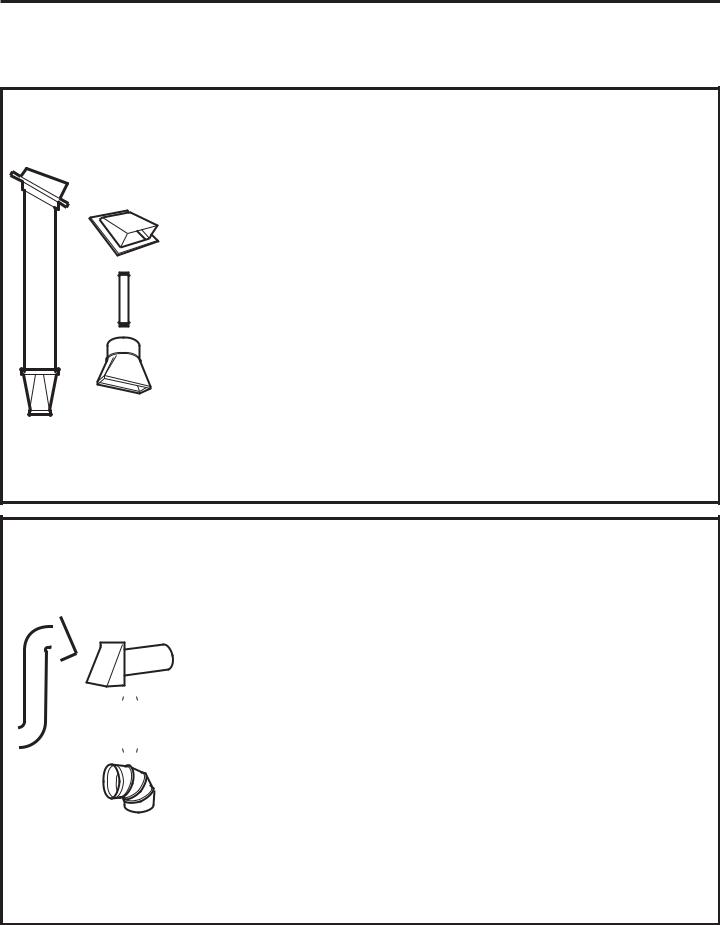
Installation Instructions
HOOD EXHAUST
NOTE: Read these next two pages only if you plan to vent your exhaust to the outside. If you plan to recirculate the air back into the room, proceed to page 6.
OUTSIDE TOP EXHAUST (EXAMPLE ONLY)
The following chart describes an example of one possible ductwork installation.
|
|
|
|
|
EQUIVALENT |
|
NUMBER |
|
EQUIVALENT |
|
DUCT PIECES |
LENGTH |
x |
USED |
= |
LENGTH |
|||||
|
|
|
|
|
|
|
|
|
|
|
|
|
|
|
Roof Cap |
24 Ft. |
x |
(1) |
= |
24 |
Ft. |
|
|
|
|
|
|
|
|
|
|
|
|
|
|
|
12 Ft. Straight Duct |
12 Ft. |
x |
(1) |
= |
12 |
Ft. |
|
|
|
|
|||||||
|
|
|
|
(6s Round) |
|
|
|
|
|
|
|
|
|
|
|
|
|
|
|
|
|
|
|
|
|
|
|
|
|
|
|
|
|
|
|
|
Rectangular-to-Round |
5 Ft. |
x |
(1) |
= |
5 Ft. |
|
|
|
|
|
Transition Adaptor* |
|
|
|
|
|
|
|
|
|
|
|
|
|
||||
Equivalent lengths of duct pieces are based on actual tests and |
|
|
|
|
||||||
reflect requirements for good venting performance with any vent hood. |
= |
41 |
Ft. |
|||||||
|
|
|
|
|
|
|
Total Length |
|||
|
|
|
|
|
|
|
|
|
|
|
|
|
|
|
|
|
|
|
|
|
|
*IMPORTANT: If a rectangular-to-round transition adaptor is used, the bottom corners of the damper will have to be cut to fit, using the tin snips, in order to allow free movement of the damper.
OUTSIDE BACK EXHAUST (EXAMPLE ONLY)
The following chart describes an example of one possible ductwork installation.
|
|
|
|
|
|
|
|
|
|
|
|
|
EQUIVALENT |
|
NUMBER |
|
EQUIVALENT |
|
|
|
|
|
|
|
|
|
DUCT PIECES |
LENGTH* |
x |
USED |
= |
LENGTH |
|||||
|
|
|
|
|
|
|
|
|||||||||||
|
|
|
|
|
|
|
|
|
|
|
|
|
|
|
|
|
|
|
|
|
|
|
|
|
|
|
|
|
|
|
Wall Cap |
40 Ft. |
x |
(1) |
= |
40 |
Ft. |
|
|
|
|
|
|
|
|
|
|
|
|
|||||||
|
|
|
|
|
|
|
|
|
|
|
|
|||||||
|
|
|
|
|
|
|
|
|
|
|
|
|
|
|
|
|
|
|
|
|
|
|
|
|
|
|
|
|
|
|
|
|
|
|
|
|
|
|
|
|
|
|
|
|
|
|
|
|
|
3 Ft. Straight Duct |
3 Ft. |
x |
(1) |
= |
3 Ft. |
|
|
|
|
|
|
|
|
|
|
|
|
|
|||||||
|
|
|
|
|
|
|
|
|
|
|
|
|||||||
|
|
|
|
|
|
|
|
|
|
|
|
|||||||
|
|
|
|
|
|
|
|
|
|
|
|
|||||||
|
|
|
|
|
|
|
|
|
|
|
|
(31ø4s x 10s Rectangular) |
|
|
|
|
|
|
|
|
|
|
|
|
|
|
|
|
|
|
|
|
|
|
|
|
|
|
|
|
|
|
|
|
|
|
|
|
|
90° Elbow |
10 Ft. |
x |
(2) |
= |
20 |
Ft. |
|
|
|
|
|
|
|
|
|
|
|
|
|||||||
|
|
|
|
|
|
|
|
|
|
|
|
|
|
|
|
|
|
|
|
|
|
|
|
|
|
|
Equivalent lengths of duct pieces are based on actual tests and |
|
|
|
|
||||||
|
|
|
|
|
|
|
|
reflect requirements for good venting performance with any vent hood. |
= |
63 |
Ft. |
|||||||
|
|
|
|
|
|
|
|
|
|
|
|
|
|
|
Total Length |
|||
|
|
|
|
|
|
|
|
|
|
|
|
|
|
|
|
|
|
|
NOTE: For back exhaust, care should be taken to align exhaust with space between studs, or wall should be prepared at the time it is constructed by leaving enough space between the wall studs to accommodate exhaust.
4
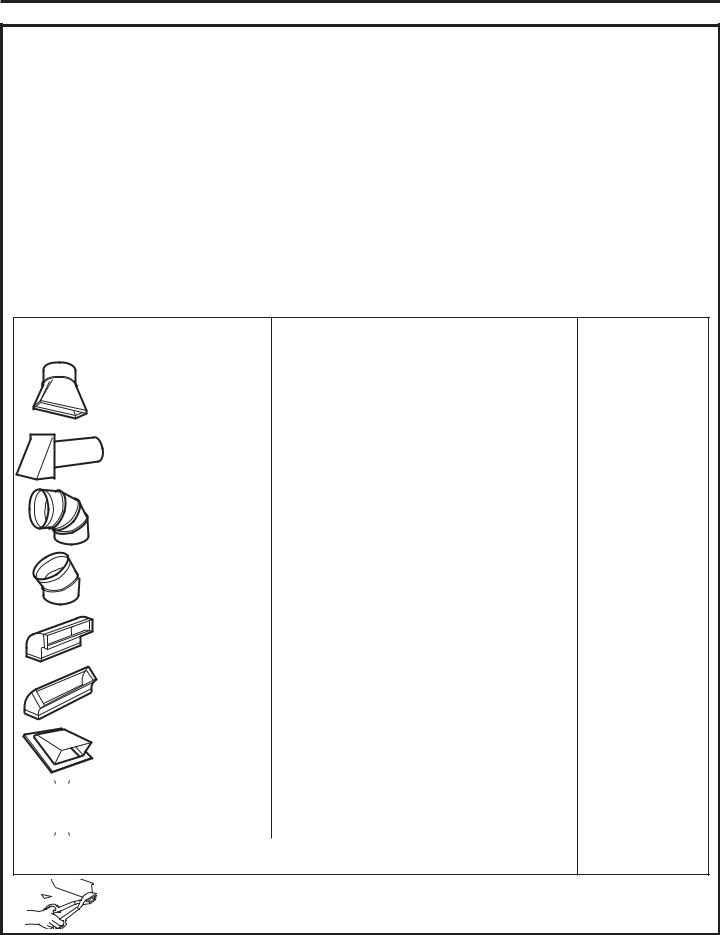
Installation Instructions
NOTE: If you need to install ducts, note that the total duct length of 31ø4s x 10s rectangular or 6s diameter round duct should not exceed 140 equivalent feet.
Outside ventilation requires a HOOD EXHAUST DUCT. Read the following carefully.
NOTE: It is important that venting be installed using
the most direct route and with as few elbows as possible. This ensures clear venting of exhaust and helps prevent blockages. Also, make sure dampers swing freely and nothing is blocking the ducts.
Exhaust connection:
The hood exhaust has been designed to mate with a standard 31ø4s x 10s rectangular duct.
If a round duct is required, a rectangular-to-round transition adaptor must be used. Do not use less than a 6s diameter duct.
Maximum duct length:
For satisfactory air movement, the total duct length of 31ø4s x 10s rectangular or 6s diameter round duct should not exceed 140 equivalent feet.
Elbows, transitions, wall and roof caps, etc., present additional resistance to airflow and are equivalent to a section of straight duct which is longer than their actual physical size. When calculating the total duct length, add the equivalent lengths of all transitions and adaptors plus the length of all straight duct sections. The chart below shows you how to calculate total equivalent ductwork length using the approximate feet of equivalent length of some typical ducts.
|
EQUIVALENT |
|
NUMBER |
|
EQUIVALENT |
DUCT PIECES |
LENGTH |
x |
USED |
= |
LENGTH |
|
|
|
|
Rectangular-to-Round |
5 Ft. |
x |
( |
) |
= |
Ft. |
|
|
|
|
|
Transition Adaptor* |
|
|
|
|
|
|
|
|
|
|
|
|
|
|
|
|
|
|
|
|
|
|
|
Wall Cap |
40 Ft. |
x |
( |
) |
= |
Ft. |
|
|
|
|
|
|
|||||||
|
|
|
|
|
|
|
|
|
|
|
|
|
|
|
|
|
|
|
|
|
|
|
|
|
|
|
|
90° Elbow |
10 Ft. |
x |
( |
) |
= |
Ft. |
|
|
|
|
|
|
|
|
|
|
|
|
|
|
|
|
|
45° Elbow |
5 Ft. |
x |
( |
) |
= |
Ft. |
|
|
|
|
|
|
|
|
|
|
|
|
|
|
|
|
|
90° Elbow |
25 Ft. |
x |
( |
) |
= |
Ft. |
|
|
|
|
|
|
|
|
|
|
|
|
|
|
|
|
|
45° Elbow |
5 Ft. |
x |
( |
) |
= |
Ft. |
|
|
|
|
|
|
|
|
|
|
|
|
|
|
|
|
|
Roof Cap |
24 Ft. |
x |
( |
) |
= |
Ft. |
|
|
|
|
|
|
|
|
|
|
|
|
|
|
|
|
|
Straight Duct 6s Round or |
1 Ft. |
x |
( |
) |
= |
Ft. |
|
|
|
|
|
|
|||||||
|
|
|
|
31ø4s x 10s Rectangular |
|
|
|
|
|
|
|
|
|
|
|
|
|
|
|
|
|
||
|
|
|
|
|
|
|
|
|
|
|
|
|
|
|
|
|
|
|
|
|
|
|
|
|
|
|
|
|
|
Total Ductwork |
= |
Ft. |
|
||
*IMPORTANT: If a rectangular-to-round transition adaptor is used, the bottom corners of the damper will have to be cut to fit, using the tin snips, in order to allow free movement of the damper.
Equivalent lengths of duct pieces are based on actual tests and reflect requirements for good venting performance with any vent hood.
5
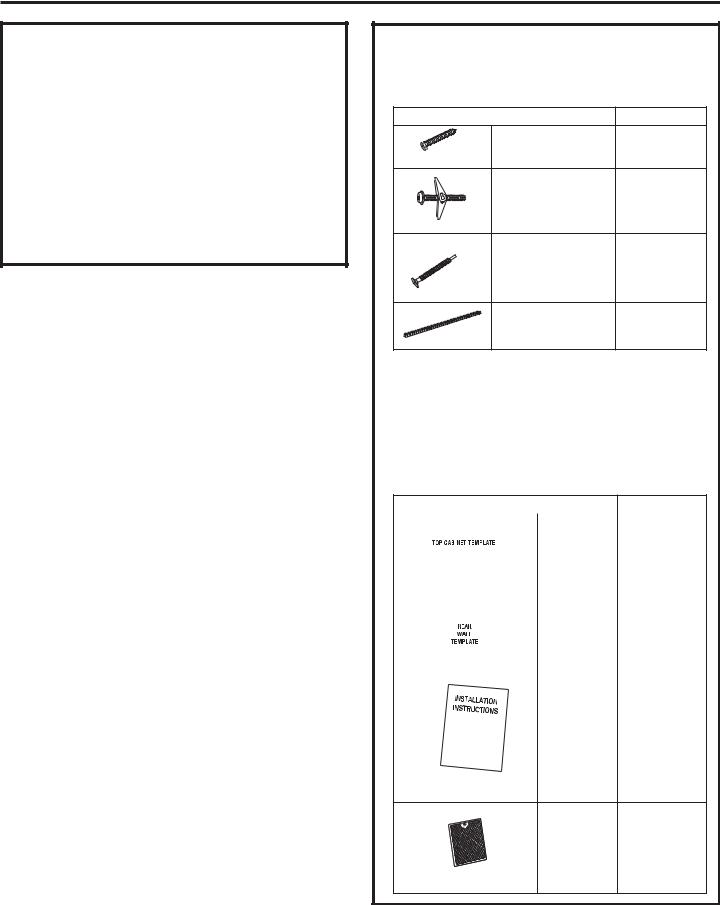
Installation Instructions
DAMAGE – SHIPMENT/ INSTALLATION
•If the unit is damaged in shipment, return the unit to the store in which it was bought for repair or replacement.
•If the unit is damaged by the customer, repair or replacement is the responsibility of the customer.
•If the unit is damaged by the installer (if other than the customer), repair or replacement must be made by arrangement between customer
and installer.
PARTS INCLUDED
HARDWARE PACKET
PART |
QUANTITY |
Wood Screws |
2 |
(1ø4s x 2s) |
|
Toggle Bolts (and |
2 |
wing nuts) (3ø16s x 3s) |
|
Self-Aligning Machine |
2 |
Screws (1ø4s-28 x 31ø4s) |
|
Nylon Grommet |
1 |
(for metal cabinets) |
|
You will find the installation hardware contained in a packet with the unit. Check to make sure you have all these parts.
NOTE: Some extra parts are included.
ADDITIONAL PARTS
|
PART |
QUANTITY |
||||||
|
|
|
|
|
|
|
Top Cabinet |
1 |
|
|
|
|
|
|
|
||
|
|
|
|
|
|
|
Template |
|
|
|
|
|
|
|
|
|
|
|
|
|
|
|
|
|
|
|
|
|
|
|
|
|
|
|
|
|
|
|
|
|
|
|
|
|
|
|
|
|
|
|
|
|
|
|
|
|
|
|
|
|
Rear Wall |
1 |
|
|
|
|
|
|
|
||
|
|
|
|
|
|
|
Template |
|
|
|
|
|
|
|
|
|
|
|
|
|
|
|
|
|
|
|
|
|
|
|
|
|
|
|
|
|
|
|
|
|
|
|
Installation |
1 |
|
|
|
|
|
|
|
Instructions |
|
|
|
|
|
|
|
|
|
|
Separately |
2 |
Packed |
1 - JVM6172 |
Grease |
1 - JVM6175 |
Filter |
|
6
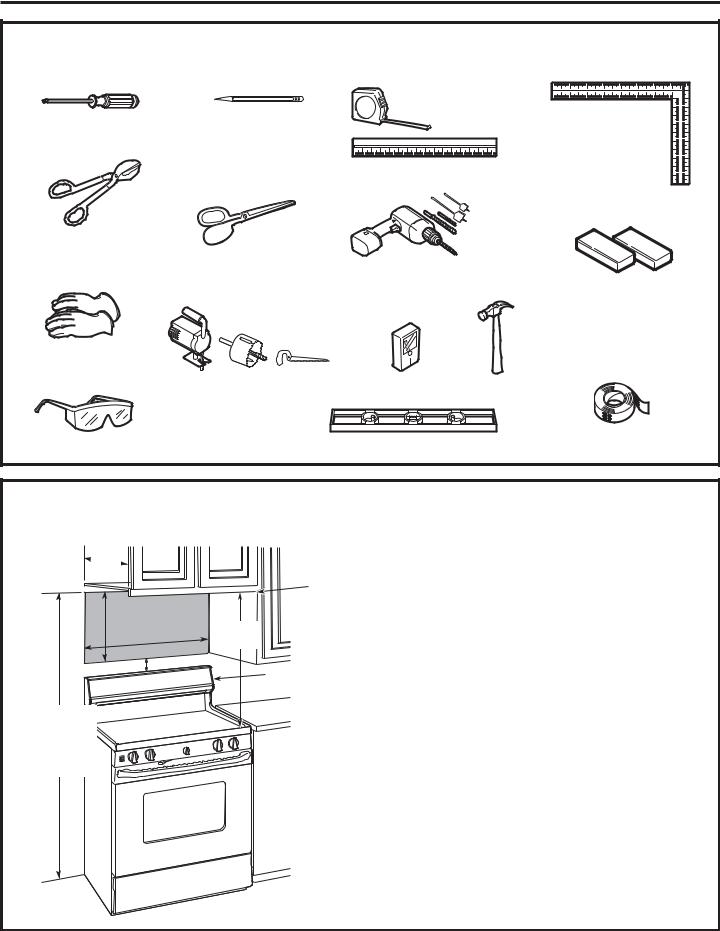
Installation Instructions
TOOLS YOU WILL NEED
|
|
Ruler or tape measure |
|
# 1 and #2 Phillips screwdriver |
Pencil |
and straight edge |
Carpenter square |
|
(optional)
Tin snips (for cutting  damper, if required) Scissors
damper, if required) Scissors
(to cut template, if necessary)
Gloves
Saw (saber, hole or keyhole)
Electric drill with 3ø16s, 1ø2s and 5ø8s drill bits
Stud finder or Hammer (optional)
Filler blocks or scrap wood pieces, if needed for top cabinet spacing (used on recessed bottom cabinet installations only)
Safety goggles |
Level |
Duct and masking tape |
|
MOUNTING SPACE
13s |
|
Bottom Edge of |
max*. |
|
|
|
|
Cabinet Needs |
|
|
to be 30s or |
|
|
More from the |
161ø2s |
|
Cooking Surface |
|
30s |
|
|
30s |
|
|
min. |
|
|
|
|
|
2s |
Backsplash |
|
|
|
66s or More |
|
|
from the |
|
|
Floor to the |
|
|
Top of the |
|
|
Microwave |
|
|
|
|
Minimum distance |
|
|
from door hinge |
|
|
side to adjacent |
|
|
wall should |
|
|
equal 3/4” |
NOTES:
•The space between the cabinets must be 30s wide and free of obstructions.
•If the space between the cabinets is greater than 30s, a Filler Panel Kit may be used to fill in the gap between the microwave oven and the cabinets. Your Owner’s Manual contains the kit number for your model.
•This microwave oven is for installation over ranges up to 36s wide.
•If you are going to vent your microwave oven to the outside, see Hood Exhaust Section for exhaust duct preparation.
•When installing the microwave oven beneath smooth, flat cabinets, be careful to follow the instructions on the top cabinet template for power cord clearance.
•Models with top venting grilles: Do not allow cabinetry or other objects to block the airflow of the vent.
*13” max: for standard installation, 15” cabinet depth requires additional steps using an additional installation kit JX15BUMPWW/BB.
7
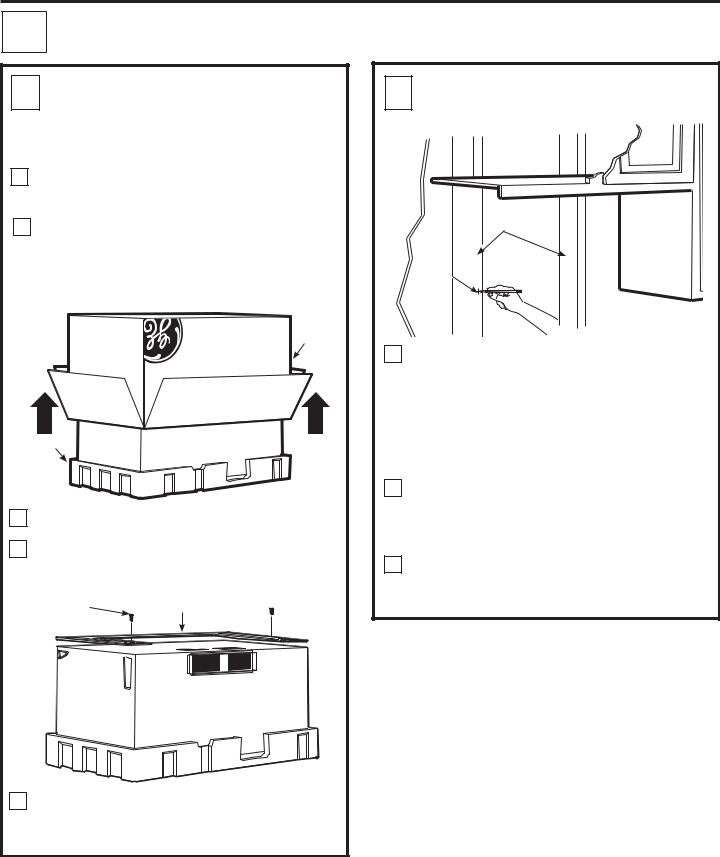
Installation Instructions
1 PLACEMENT OF THE MOUNTING PLATE
A. REMOVING THE MICROWAVE
OVEN FROM THE CARTON/ REMOVING THE MOUNTING PLATE
1Remove the installation instructions, filters, glass tray and the small hardware bag. Do not remove the foam protecting the front of the oven.
2Fold back all 4 carton flaps fully against carton sides. Then carefully roll the oven and carton over onto the top side. The oven should be resting in the foam.
Carton
foam
3Pull the carton up and off the oven.
4Remove and properly discard plastic bags.
Screws |
Mounting |
Plate |
B. FINDING THE WALL STUDS
Wall
Studs
Center
1Find the studs, using one of the following methods:
A.Stud finder – a magnetic device which locates nails.
OR
B. Use a hammer to tap lightly across the mounting surface to find a solid sound. This will indicate a stud location.
2After locating the stud(s), find the center by probing the wall with a small nail to find the edges
of the stud. Then place a mark halfway between the edges. The center of any adjacent studs should be 16s or 24s from this mark.
3 Draw a line down the center of the studs.
THE MICROWAVE MUST BE CONNECTED TO AT LEAST ONE WALL STUD.
5Remove the 2 screws from the mounting plate. This plate will be used as the rear wall template and for mounting. You may discard these screws.
8
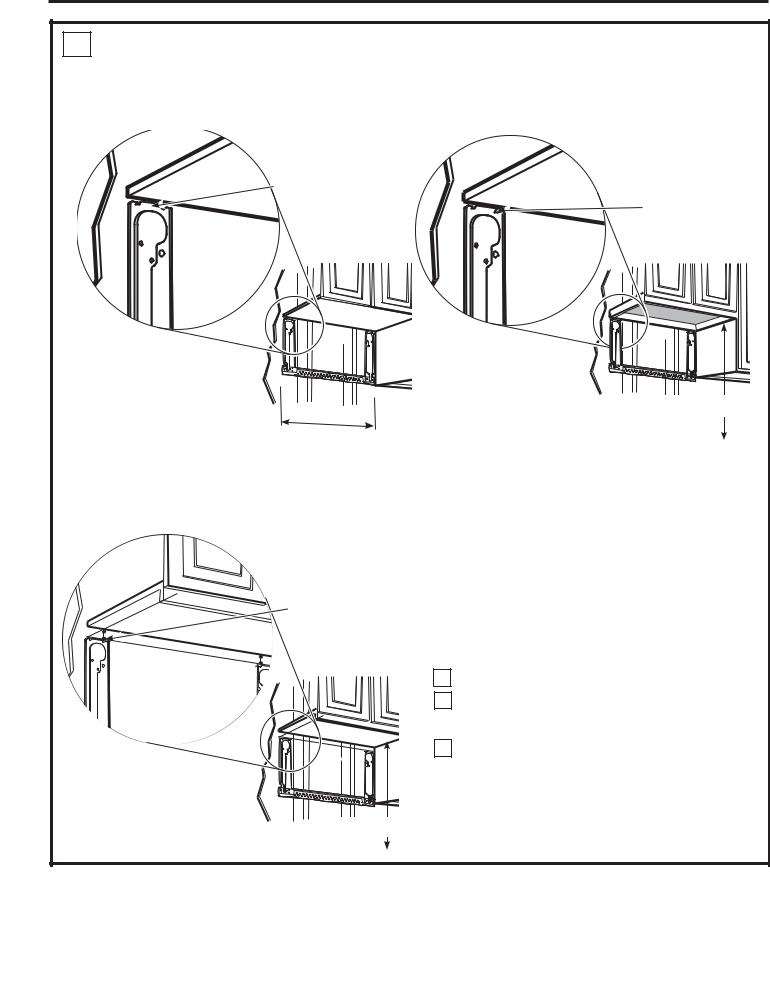
Installation Instructions
C. DETERMINING WALL PLATE LOCATION UNDER YOUR CABINET
Plate position – beneath flat bottom cabinet
Plate position – beneath framed recessed cabinet bottom
Mounting Plate Tabs
Touching the Cabinet
Bottom
At least 30s, up to 36s
Plate position – beneath recessed bottom cabinet with front overhang
Mounting Plate with
Tabs Below Cabinet
Bottom the Same
Distance as the Front
Overhang Depth
Mounting Plate Tabs
Touching the Back
Frame
30s to Cooktop
Your cabinets may have decorative trim that interferes with the microwave installation. Remove the decorative trim to install the microwave properly and to make it level.
THE MICROWAVE MUST BE LEVEL.
Use a level to make sure the cabinet bottom is level.
If the cabinets have a front overhang only, with no back or side frame, install the mounting plate down the same distance as the front overhang depth. This will keep the microwave level.
1 Measure the inside depth of the front overhang.
2Draw a horizontal line on the back wall an equal distance below the cabinet bottom as the inside depth of the front overhang.
3For this type of installation with front overhang only, align the mounting tabs with this horizontal line, not touching the cabinet bottom as described in Step D.
30s to Cooktop
9
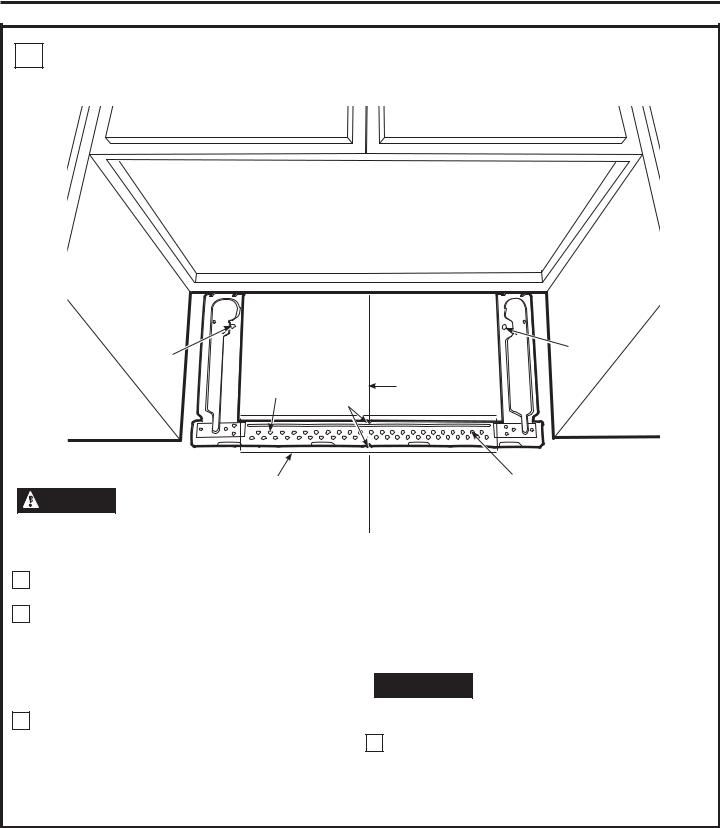
Installation Instructions
D. ALIGNING THE WALL PLATE
Hole A |
Hole B |
|
Draw a Vertical |
||
|
||
Hole C Centerline |
Line on Wall |
|
from Center of |
||
Notches |
Top Cabinet |
|
Area E |
Hole D |
|
CAUTION |
|
Wear gloves to avoid cutting fingers on sharp edges.
1
2
3
Draw a vertical line on the wall at the center of the 30s wide space.
Use the mounting plate as the template for the rear wall. Place the mounting plate on the wall, making sure that the tabs are touching the bottom of the cabinet or the level line drawn in Step C for cabinets with front overhang. Line up the notch and centerline
on the bottom of the mounting plate to the centerline on the wall.
While holding the mounting plate with one hand, draw circles on the wall at holes A, B, C and D
(see illustration above/actual plate marked with arrows).
Four holes must be used for mounting.
NOTE: Holes C and D are inside area E. If neither
C nor D is in a stud, find a stud somewhere in area E and draw a fifth circle to line up with the stud. It is important to use at least one wood screw mounted
firmly in a stud to support the weight of the microwave.
Set the mounting plate aside.

 WARNING Risk of electric shock. Can cause injury or death. Take care to not drill into electrical wiring inside walls or cabinets.
WARNING Risk of electric shock. Can cause injury or death. Take care to not drill into electrical wiring inside walls or cabinets.
4Drill holes on the circles. If there is a stud, drill a 3ø16s hole for wood screws. For holes that don’t line up with a stud, drill a 5ø8s hole for toggle bolts. Drill two 5/8” holes for toggle screws.
NOTE: DO NOT MOUNT THE PLATE AT THIS TIME.
10
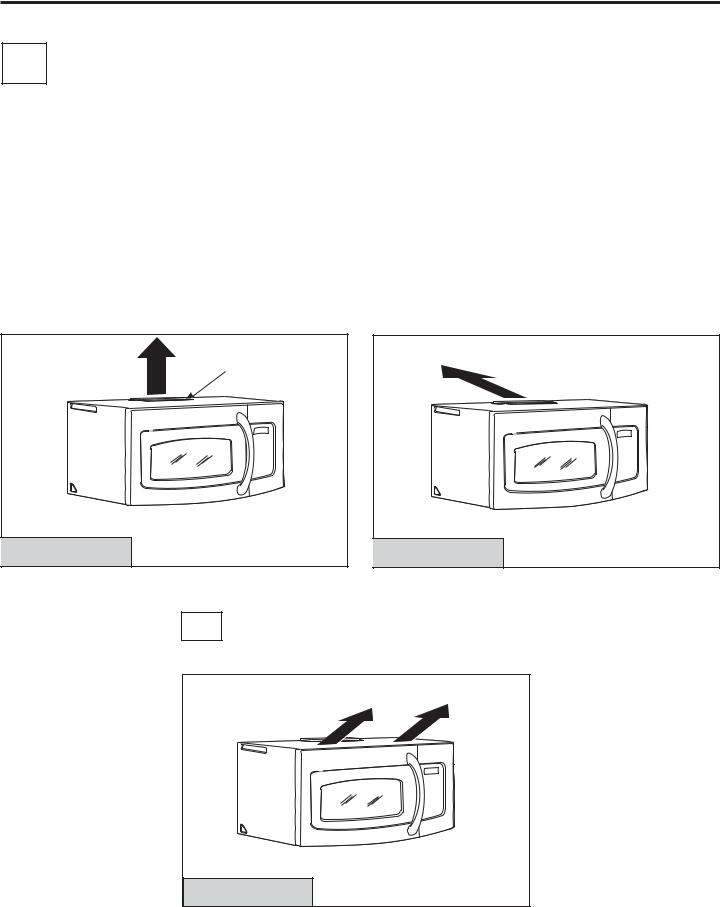
Installation Instructions
2 INSTALLATION TYPES (Choose A, B or C)
This microwave oven is designed for adaptation to the following three types of ventilation:
A.Outside Top Exhaust (Vertical Duct)
B.Outside Back Exhaust (Horizontal Duct)
C.Recirculating (Non-Vented Ductless)
NOTE: This microwave is shipped assembled for Outside Top Exhaust (except for non-vented models). Select the type of ventilation required for your installation and
proceed to that section.
|
OUTSIDE TOP EXHAUST |
|
OUTSIDE BACK EXHAUST |
A |
B |
||
|
(VERTICAL DUCT) |
|
(HORIZONTAL DUCT) |
|
|
Adaptor in Place for |
Outside Top Exhaust |
See page 12 |
See page 16 |
CRECIRCULATING (NON-VENTED DUCTLESS)
A Charcoal Filter Accessory Kit is required for the non-vented exhaust. (See your
Owner’s Manual for the kit number.)
See page 20
11
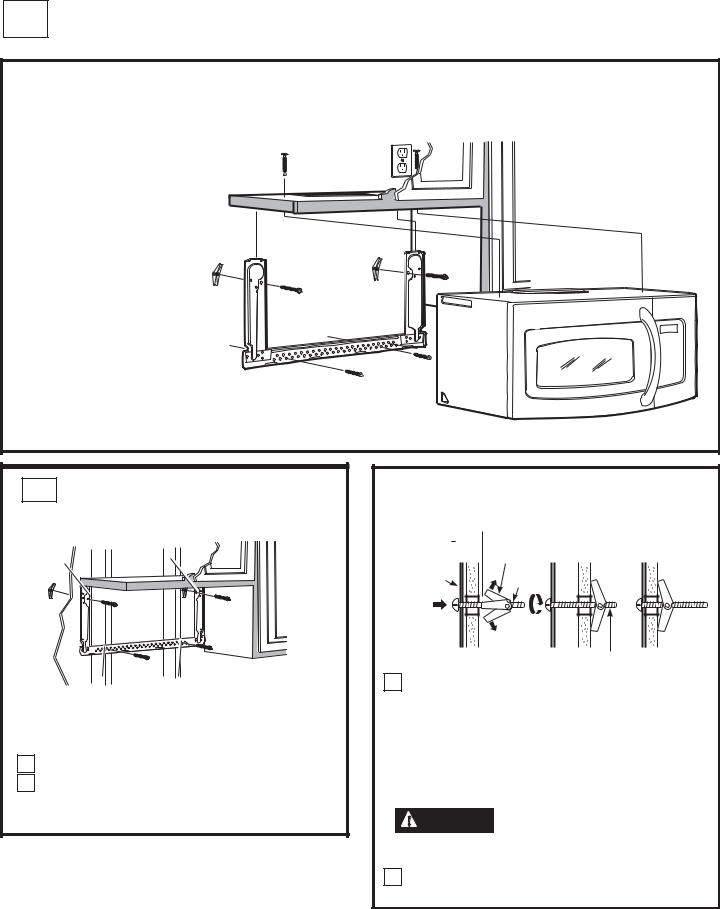
Installation Instructions
A OUTSIDE TOP EXHAUST (Vertical Duct)
INSTALLATION OVERVIEW
A1. Attach Mounting Plate to Wall
A2. Prepare Top Cabinet
A3. Check Blower Motor Oientation
A4. Adapt Blower for Outside Ventilation
A5. Check Damper Operation
A6. Mount Microwave Oven
A7. Adjust Exhaust Adaptor
A8. Connect Ductwork
A1 ATTACH THE MOUNTING PLATE TO THE WALL
A B
C D
Attach the plate to the wall using toggle bolts. At least one wood screw must be used to attach the plate to a wall stud. Recommended locations on the mounting plate are indicated by A, B, C and D.
1Remove the toggle wings from the bolts.
2Insert the bolts into the mounting plate through
the holes designated to go into drywall and reattach the toggle wings to 3ø4s onto each bolt.
12
To use toggle bolts:
Spacing for
Toggles More Than


 Wall Thickness
Wall Thickness
Mounting |
Toggle Wings |
|
Toggle |
||
Plate |
||
Bolt |
||
|
 Wall
Wall
Bolt End
3Place the mounting plate against the wall and insert the toggle wings into the holes in the wall
to mount the plate.
NOTE: Before tightening toggle bolts and wood screw, make sure the tabs on the mounting plate touch the bottom of the cabinet when pushed
flush against the wall and that the plate is properly centered under the cabinet.
CAUTION |
Be careful to avoid pinching |
|
fingers between the back of the mounting plate and the wall.
4Tighten all bolts. Pull the plate away from the wall to help tighten the bolts.
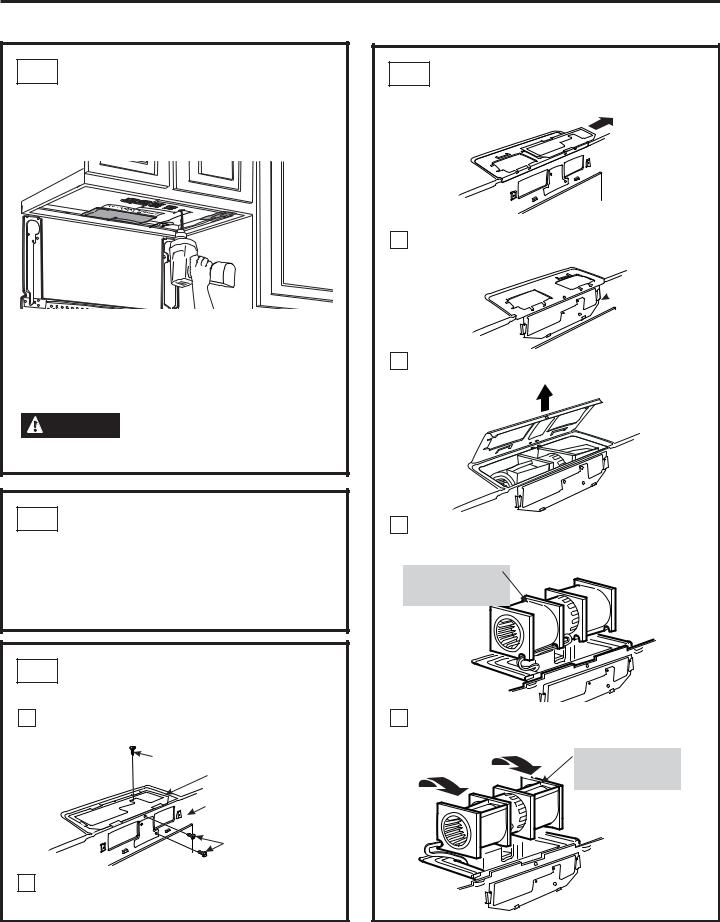
Installation Instructions
A2. USE TOP CABINET TEMPLATE FOR
PREPARATION OF TOP CABINET
You need to drill holes for the top support screws, a hole large enough for the power cord to fit through, and a cutout large enough for the exhaust adaptor.
•Read the instructions on the TOP CABINET TEMPLATE.
•Tape it underneath the top cabinet.
•Drill the holes, following the instructions on the TOP CABINET TEMPLATE.
CAUTION |
Wear safety goggles when drilling |
holes in the cabinet bottom. |
|
A3. CHECK BLOWER MOTOR
ORIENTATION
The blower fan blade opening should be facing the top of the microwave. If the fan opening is already facing the top of the microwave, skip to Step A5. Otherwise, continue to Step A4 to adjust the motor orientation.
A4. ADAPTING BLOWER FOR
OUTSIDE VENTILATION
1Remove and save the screws that hold the blower motor to the microwave oven.
Blower Motor |
|
Screw |
Blower Plate |
|
|
|
Back of Oven |
|
Blower Motor |
|
Screws |
2Remove and save the metal blower shield on the top of the microwave by sliding it right.
A4. ADAPTING BLOWER FOR
OUTSIDE VENTILATION (Cont.)
3Attached the metal blower shield to the backside of the microwave oven by sliding it down.
Blower





 Shield
Shield
4Open the blower door by lifting it up at the back of the microwave oven.
5Carefully pull out the blower unit. The wires will extend far enough to allow you to adjust the blower unit.
BEFORE: Fan Blade
Openings Facing
Forward
65ROO WKH EORZHU XQLW Û VR WKDW WKH IDQ EODGH openings are facing the top.
AFTER: Fan Blade
Roll Openings Facing
Up
NOTE: Make sure wires remain routed in the grooves of the motor frame.
13
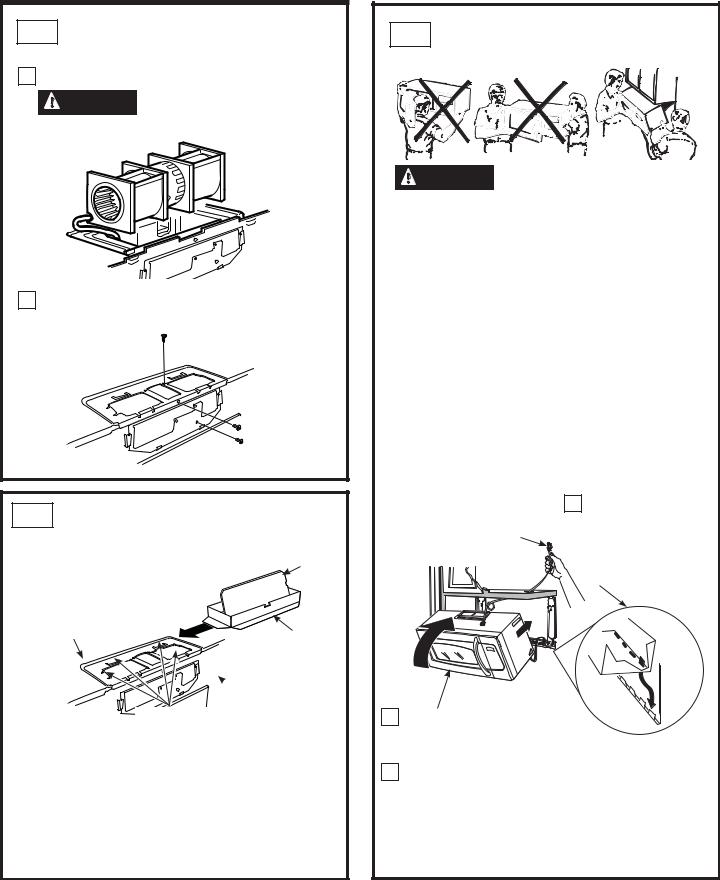
Installation Instructions
A4. ADAPTING BLOWER FOR
OUTSIDE VENTILATION (Cont.)
7 Place the blower unit back into the opening.
CAUTION |
Do not pull or stretch the blower |
|
unit wiring. Make sure the wires are not pinched.
8Close the blower door. Secure the blower to the microwave using the screws from Step 1.
A5. CHECK FOR PROPER
DAMPER OPERATION
Damper
Blower Plate |
Exhaust Adaptor |
|
Back of
 Microwave
Microwave
Oven
Retaining Hooks
•Place the microwave in its upright position, with the top of the unit facing up.
•Make sure tape securing damper is removed and damper pivots easily before mounting microwave.
•Slide the damper into place. Make sure it catches in the retaining hooks to secure.
•You will need to make adjustments to assure proper alignment with your house exhaust duct after the microwave is installed.
A6. MOUNT THE MICROWAVE OVEN
CAUTION |
FOR EASIER INSTALLATION AND |
|
|
PERSONAL SAFETY, WE RECOMMEND THAT TWO |
|
PEOPLE INSTALL THIS MICROWAVE OVEN. |
|
IMPORTANT: Do not grip or use handle during installation.
NOTE: If your cabinet is metal, use the nylon grommet around the power cord hole to prevent cutting of the cord.
NOTE: We recommend using filler blocks if the cabinet front hangs below the cabinet bottom shelf.
IMPORTANT: If filler blocks are not used, case damage may occur from overtightening screws.
NOTE: When mounting the |
|
microwave oven, thread |
|
power cord through hole |
|
in bottom of top cabinet. |
|
Keep it tight throughout |
1 Lift microwave, tilt it |
Steps 1–3. Do not pinch |
|
cord or lift oven by pulling |
forward, and hook slots |
cord. |
at back bottom edge |
|
onto four lower tabs of |
|
mounting plate. |
2 Rotate front of oven up against cabinet bottom.
3Insert a self-aligning screw through top center cabinet hole. Temporarily secure the oven by turning the screw at least two full turns after the threads have engaged. (It will be completely
tightened later.) Be sure to keep power cord tight.
Be careful not to pinch the cord, especially when mounting flush to bottom of cabinet.
14

Installation Instructions
A6. MOUNT THE MICROWAVE OVEN (cont.)
Cabinet Front
Cabinet Bottom Shelf
Filler Block
Equivalent to Depth of Cabinet Recess

 Self-Aligning Screw
Self-Aligning Screw
Microwave Oven Top
4 Attach the microwave oven to the top cabinet.
5Insert 2 self-aligning screws through outer top cabinet holes. Turn two full turns on each screw.
6Tighten the outer two screws to the top of the microwave oven. (While tightening screws, hold the microwave oven in place against the wall and the top cabinet.)
7Install grease filter. See the Owner’s Manual on the website (GEAppliances.com).
A7. ADJUST THE EXHAUST ADAPTOR
Open the top cabinet and adjust the exhaust adaptor to connect to the house duct.
Damper |
Back of |
|
Microwave |
|
Oven |
For Side-to-Side Adjustment,
Slide the Exhaust Adaptor
as Needed
A8. CONNECTING DUCTWORK
House Duct
1Extend the house duct down to connect to the exhaust adaptor.
2 Seal exhaust duct joints using duct tape.
15
